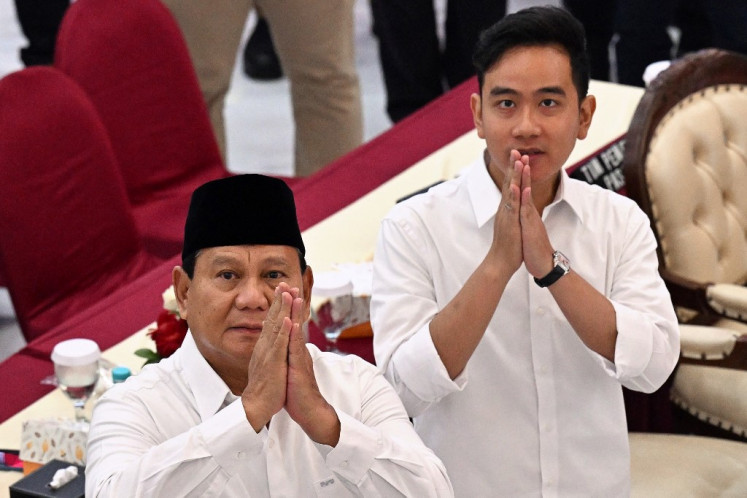Terrorists utilize the Internet to spread hate, recruit
Dangerous recipe: A post on a blog under the name Asykarulloh Al Hafidz demonstrates how to make nitroglycerin, a main ingredient of dynamite
Change Size
 Dangerous recipe: A post on a blog under the name Asykarulloh Al Hafidz demonstrates how to make nitroglycerin, a main ingredient of dynamite. The blog can be accessed at fadliistiqomah.blogspot.com. (JP) (JP)
Dangerous recipe: A post on a blog under the name Asykarulloh Al Hafidz demonstrates how to make nitroglycerin, a main ingredient of dynamite. The blog can be accessed at fadliistiqomah.blogspot.com. (JP) (JP)
D
span class="inline inline-none">Dangerous recipe: A post on a blog under the name Asykarulloh Al Hafidz demonstrates how to make nitroglycerin, a main ingredient of dynamite. The blog can be accessed at fadliistiqomah.blogspot.com. (JP)
Terror fugitive Santoso's recent video, posted on YouTube on Sunday, illustrates the contemporary methods used by terrorist cells to employ cyberspace ' and social networking in particular ' to incite hate.
The six-minute video was viewed thousands of times before it was taken down on Wednesday, four days after it was uploaded.
In the video Santoso, a terrorist suspect responsible for a number of terror attacks in Poso, called on jihadists across the country to fight against the National Police's Densus 88 counterterrorism squad.
According to Noor Huda Ismail, a terrorism expert, Santoso intended his vitriolic attack on Densus 88 to be a wake-up call for other jihadists.
'The terrorists are using the Internet because it is limitless and they can remain anonymous. They use it for propaganda, recruitment and knowledge-sharing,' Noor Huda said on Wednesday.
As a way to prevent extremist groups from disseminating their ideologies through the Internet, the Communications and Information Ministry, in 2011, blocked no less than 300 websites deemed 'radical'.
But despite it's efforts, several websites promoting terrorism remain accessible.
A blog ' fadliistiqomah.blogspot.com ' written under the assumed pseudonym Asykarulloh Al Hafidz demonstrates how to make dynamite and bombs. The writer has also posted several articles directed at incarcerated jihadists or those recently released from prison.
'O my brothers, who are shackled in prison, I pray to God to make you strong and bind your heart so that your enemies and their allies cannot tempt you with worldly things,' the blog author posted.
Another website, nii-news-document.blogspot.com, contains messages calling Muslims in the country to struggle for the establishment of the 'Islamic state of Indonesia'.
In addition to using the Internet to spread their ideologies, extremist groups have also used it for recruitment and fundraising purposes.
In May, the counterterrorism squad found that a terrorist group was actively recruiting through the social networking website Facebook. The police also determined that a Facebook page had played a part in terrorist suspect Sefa Riano's bombing of the Myanmar Embassy in Jakarta.
Sefa Riano's Facebook account, under the name Mambo Wahab, was removed by Facebook after he posted a message saying he would take action at the Myanmar Embassy and hoped others would support him.
Last year, the counterterrorism squad also arrested a group of terrorists who hacked the website of a Multi Level Marketing (MLM) company, skimming off Rp 5.9 billion (US$591,929) during the effort, which was later used to part fund an attack on a church in 2011.
Terrorism expert from the International Crisis Group, Sidney Jones, said on Thursday that terrorist groups had been using the internet since 2003 for communication, recruitment and fundraising. She said that this, however, was actually a sign of weakness as 10 years ago they had training camps in various parts of the country.
'The Internet is not the most significant way terrorists recruit new members. What I have seen is that the most effective recruitment is at traditional places, such as pengajian [prayer meetings],' she said.
She explained that there were not many cases of people being radicalized through the Internet and going on to commit violent acts.
'There were one or two terrorist acts inspired by literature on the Internet. One example is the bombing of A&W restaurant in 2005,' she said.
Indonesia has been engaged in a war against terrorism since the Bali bombing in 2002, Densus 88 have played an integral part.
It successfully killed two prominent terrorist figures Azahari bin Husin in 2005 and Noordin M. Top in 2009. Both men had been involved in major terror attacks across the country, such as the first Bali bombing in 2002, the bombing of the JW Marriott Hotel in Jakarta in 2003, and the explosion in front of Australian Embassy in 2004. The three attacks claimed 225 lives in total. (koi)









